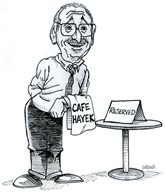“Subaru is the latest carmaker to hike prices in response to tariffs” – so reports Eric Boehm. A slice:
New cars from Japanese automaker Subaru will reportedly increase in price by several hundred dollars in the coming weeks—and tariffs are the likely culprit.
Officially, Subaru of America says it has “adjusted its pricing in response to current market conditions.” That’s what the company said in a statement to Reuters, which first reported on the price hikes.
The biggest change to the market for imported cars, of course, is the 25 percent tariff that the Trump administration announced in March. At the time, the White House said the tariffs would incentivize domestic automobile manufacturing and reduce “American reliance on imports of foreign automobiles.” The auto industry responded by pointing out that global supply chains are essential even for vehicles that are made in the United States and warning that the tariffs would likely increase sticker prices for consumers.
Desmond Lachman warns of the “import tariff economic headwinds.” Two slices:
If there is one thing about which we can be sure, it is that the high degree of import tariff policy uncertainty that has characterized the Trump 2.0 administration to date will not dissipate anytime soon. If there is also anything about which we can be confident, it is that at the end of the day, the import tariff level under Trump 2.0 will continue to be at its highest level since the 1930s.
…..
Even in the best of circumstances, the most we can expect from the Trump administration is that the current status quo of import tariffs will be maintained. If that is the case, then our effective average import tariff rate will have increased from less than 3 percent at the start of the year to around 18 percent at present. However, there is a good chance that tariffs will be meaningfully higher than that since not all countries, and especially not China, will be amenable to quick trade deals that will meet the administration’s demands. There is also a good chance that additional sectoral tariffs of 25 percent will also be imposed.
Bob Graboyes continues to write insightfully about trade.
Consider the growing evidence from Trumponomics 2.0: a universal 10 percent tariff, and then pressure on Walmart to “eat” these costs rather than raise prices; directing Apple against increased Indian manufacturing; and demanding pharmaceutical companies meet arbitrary price targets. Each intervention — even if just a bully-pulpit nudge via social media — substitutes presidential vibes for market intelligence.
These actions embody precisely the “fatal conceit” that Nobel laureate Friedrich Hayek warned against – the wrongheaded assumption that politicians can orchestrate economic activity better than millions of consumers, businesses, and investors making independent decisions. “The curious task of economics,” Hayek noted, “is to demonstrate to men how little they really know about what they imagine they can design.”
Sorry, Mr. Trump, no single authority (regardless of self-proclaimed stability of genius) can process the staggering information generated by our collective economic choices and expressed through the price mechanism. Central planning also distorts incentives, another pillar of a well-functioning market economy. Without profit and loss signals to guide decisions, the motivation for corporate efficiency improvements and technological innovation tends to diminish — something industrial policy advocates too often underweight.
GMU Econ alum Dominic Pino explains “why the senior poverty rates looks worse than it really is.” A slice:
Andrew Biggs of the American Enterprise Institute explains in a Substack post the simple reason that this statistic looks the way it does: It doesn’t count withdrawals from retirement accounts as income.
Laura Williams explains what happened when Pol Pot read a book on Marx. A slice:
Recent polling reveals a startling development: one in four young people has a positive view of communism as an economic system.
One in four is, by chance, around the same percentage of Cambodians who were murdered by the Khmer Rouge government’s policies of political torture, arbitrary execution, forced labor, mass resettlement, and brutal, intentional starvation in the 1970s. Between two and three million people were killed in just three years under a “political experiment” run by young people who were, unbelievable as it may seem, convinced they were remaking the country into a peaceful, egalitarian utopia.



